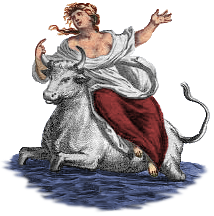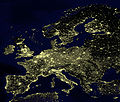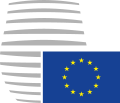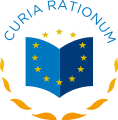Portal:European Union
Introduction
The European Union (EU) is a supranational political and economic union of 27 member states that are located primarily in Europe. The Union has a total area of 4,233,255 km2 (1,634,469 sq mi) and an estimated total population of over 449 million. The EU has often been described as a sui generis political entity combining the characteristics of both a federation and a confederation. Containing 5.8% of the world population in 2020, EU member states generated a nominal gross domestic product (GDP) of around US$16.6 trillion in 2022, constituting approximately one sixth of global nominal GDP. Additionally, all EU states except Bulgaria have a very high Human Development Index according to the United Nations Development Programme. Its cornerstone, the Customs Union, paved the way to establishing an internal single market based on standardised legal framework and legislation that applies in all member states in those matters, and only those matters, where the states have agreed to act as one. EU policies aim to ensure the free movement of people, goods, services and capital within the internal market; enact legislation in justice and home affairs; and maintain common policies on trade, agriculture, fisheries and regional development. Passport controls have been abolished for travel within the Schengen Area. The eurozone is a group composed of the 20 EU member states that have fully implemented the economic and monetary union and use the euro currency. Through the Common Foreign and Security Policy, the union has developed a role in external relations and defence. It maintains permanent diplomatic missions throughout the world and represents itself at the United Nations, the World Trade Organization, the G7 and the G20. Due to its global influence, the European Union has been described by some scholars as an emerging superpower. In 2012, the EU was awarded the Nobel Peace Prize. The United Kingdom became the only member state to leave the EU, in 2020; ten countries are aspiring or negotiating to join it. (Full article...) Selected articleThe Treaties of Rome are two of the treaties of the European Union signed on March 25, 1957. Both treaties were signed by The Six: Belgium, France, Italy, Luxembourg, the Netherlands and West Germany. The first established the European Economic Community (EEC) and the second established the European Atomic Energy Community (EAEC or Euratom). They were the first international organisations to be based on supranationalism, after the European Coal and Steel Community (ECSC) established a few years prior. The treaties came into force on 1 January 1958 and the EEC treaty has been amended on numerous occasions (see Treaties of the European Union); It has since been renamed from The Treaty establishing the European Economic Community to the The Treaty establishing the European Community. However the Euratom treaty has seen very little amendment due to the later sensitivity surrounding atomic energy amongst the European electorate. Selected picturePainting credit: Ambrosius Bosschaert Ambrosius Bosschaert (1573–1621) was a Flemish-born Dutch still-life painter and art dealer. A rising interest in botany and a passion for flowers led to an increase in still-life paintings of flowers at the end of the 1500s in the Netherlands and Germany, and Bosschaert was the first great Dutch specialist in the genre. In this oil-on-copper painting, butterflies, a dragonfly, a bumblebee and a caterpillar are nestled among roses, forget-me-nots, lilies-of-the-valley, tulips and other flowers. The painting is in the collection of the J. Paul Getty Museum in Los Angeles, California.
Did you know?...that Romania and Bulgaria became full members of the European Union on January 1, 2007? ...that the European Union's member states combined represent the world's largest economy by GDP, larger than the United States, the People's Republic of China, and Japan, the seventh largest territory in the world by area and the third largest by population after China and India? Selected cityPrague is the capital and largest city of the Czech Republic. Situated on the Vltava river in central Bohemia, it is home to approximately 1.2 million people. Since 1992, the historic center of Prague has been included in the UNESCO list of World Heritage Sites. According to Guinness World Records, Prague Castle is the largest ancient castle in the world. The land where Prague was to be built has been settled since the Paleolithic Age. Several thousands of years ago, there were trade routes connecting southern parts of Europe to northern Europe which passed through this area, following the course of the river. From around 500 BC the Celtic tribe known as the Boii, were the first known inhabitants of this region known by name. The Boii named the region Bohemia and the river Vltava. In between the 6th and 9th centuries AD the Germanic tribe Marcomanni migrated to Bohemia and other Germanic tribes followed during the 5th century AD, but in the 6th century their elites and majority of inhabitants moved to the Danubian area which enabled a Slavic tribe invading from the West, to settle this area. The Czech Slavic tribe came to Bohemia in the 6th century and Forefather Czech became the founder of the Czech nation. General imagesThe following are images from various European Union-related articles on Wikipedia.
TopicsFeatured contentFeatured articles
Featured lists
Featured contentGood articles
CategoriesRelated portalsAssociated WikimediaThe following Wikimedia Foundation sister projects provide more on this subject:
Discover Wikipedia using portals |

































































